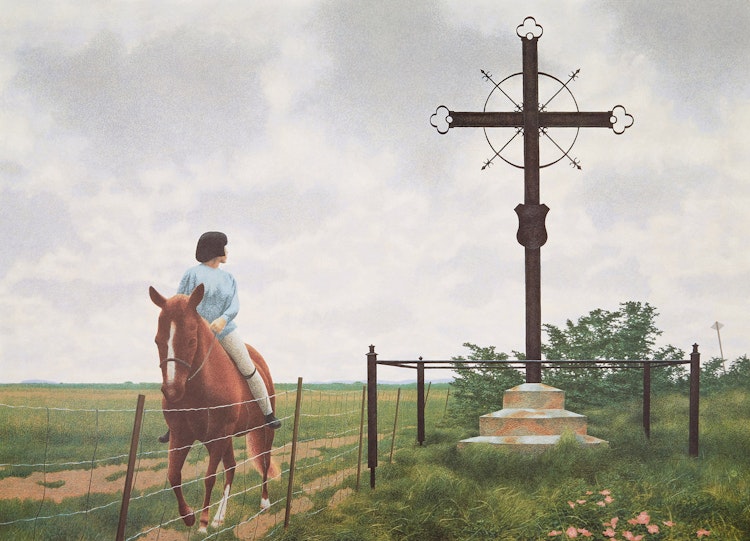French Cross; Target Shooting by David Alexander Colville

Alex Colville
French Cross; Target Shooting
two photolithographic reproductions
- “French Cross” (signed, titled, numbered “44/100” and inscribed “A.P.” in the lower margin - 23.25 x 30 ins. [sheet]);
- “Target Shooting” (signed, titled, numbered “16/100” and inscribed “A.P.” in the lower margin - 22.5 x 21.75 ins. [sheet]);
each unframed
23.25 x 30 ins ( 59.1 x 76.2 cms ) ( sheet (larger work) )
Auction Estimate: $700.00 - $900.00
Price Realized $1,200.00
Sale date: August 15th 2023
Private Collection, Toronto
Share this item with your friends
David Alexander Colville
(1920 - 2013) Order of Canada, RCA
Credited as a Maritime painter, David Alexander Colville was born in Toronto, Ontario, in 1920. Colville’s father worked in construction, so their family moved to St. Catharines, Ontario, in 1927, and then to Amherst, Nova Scotia, in 1929. Soon after the move to Nova Scotia, Colville contracted pneumonia. Through his six-month long recovery his mother supplied him with art materials, which aided his blossoming interest in the field. During this time, he exclusively drew machines, cars, and boats.
In 1934, Colville began taking weekly art classes under Sarah Hart, as an extension from Mount Allison University’s fine art department, who taught in a style that was influenced by the Post-Impressionists. Later, in 1938, Colville enrolled in Mount Allison’s art department and decided to become an artist. Colville enlisted in the First Canadian Army in the spring of 1942 after graduation. Serving as a lieutenant in Fredericton, New Brunswick, and Camp Petawawa, Ontario, until he began service as an official war artist in England. While in Yorkshire, Colville made sketches of the preparation of equipment to be sent to France for the D-Day effort. In October 1944, he was present at the liberation of the Bergen-Belsen concentration camp. Several weeks later he returned to Ottawa where he created paintings from his sketches and watercolours.
After leaving military life Colville was offered a faculty position at Mount Allison. After settling in Sackville with his family he concentrated on teaching and growing his family. At this time he was influenced by ancient Egyptian art that featured humans in frontal and profile positions. In 1951, Colville had his first solo show at the New Brunswick Museum in St. John. The works included in the exhibition included landscapes of what he saw around him in the Maritimes. This exhibition was influential on Colville’s life as it was the first time his work was written about in newspapers, the first time he lectured publicly on his art, and his first sale to a museum. Throughout the rest of the 1950s, Colville exhibited regularly in New York and throughout Canada in Toronto, Ottawa, and Hamilton.
Colville resigned from Mount Allison in 1963 to focus on his art career. During this period, he worked on important exhibitions, solo shows, and his inclusion in the 1966 Venice Biennale. In 1965, Colville designed circulation coins for Canada’s centennial, which allowed his work to reach the largest possible audience. During the 1960s, Colville was elected to the Order of Canada, received honorary degrees from Trent University, Mount Allison, and Dalhousie University. He traveled to Santa Cruz, California, in 1967-68 to work as a visiting artist at the University of California. In 1971, he was an artist in residence in Berlin.
Colville’s success continued throughout the 1970s and 1980s. He was awarded the Canada Council Molson Prize in 1974 and earned more honorary degrees from Canadian universities. In 1981, Colville was named the chancellor of Acadia University––a position he held for ten years. In 1983, The Art Gallery of Ontario held his first museum retrospective, which toured Canada and Germany.
Literature Sources
Ray Cronin, “Alex Colville: Life and Work”, Art Canada Institute, Toronto, 2017 (https://aci-iac.ca/art-books/alex-colville)
"A Dictionary of Canadian Artists, Volume I: A-F", compiled by Colin S. MacDonald, Canadian Paperbacks Publishing Ltd, Ottawa, 1977

